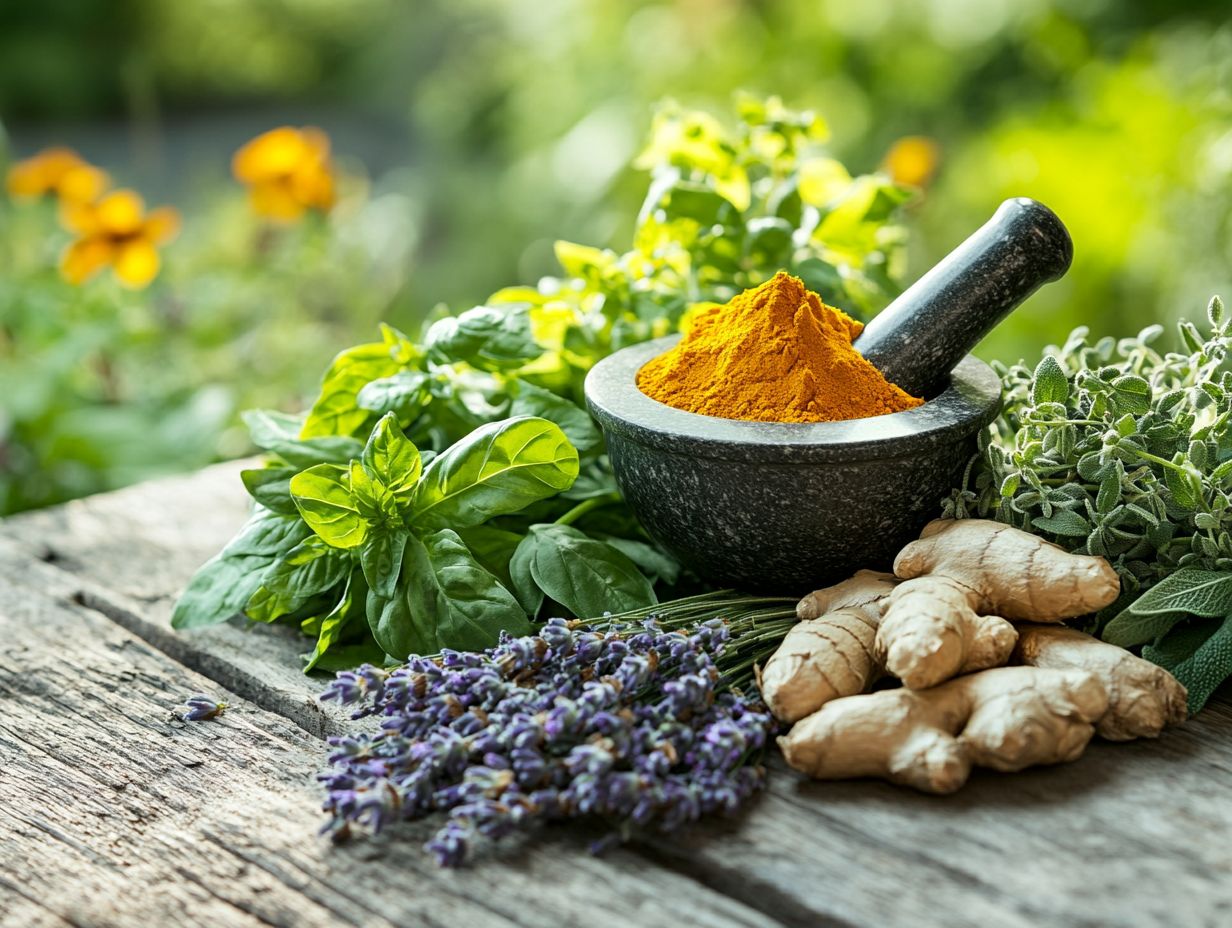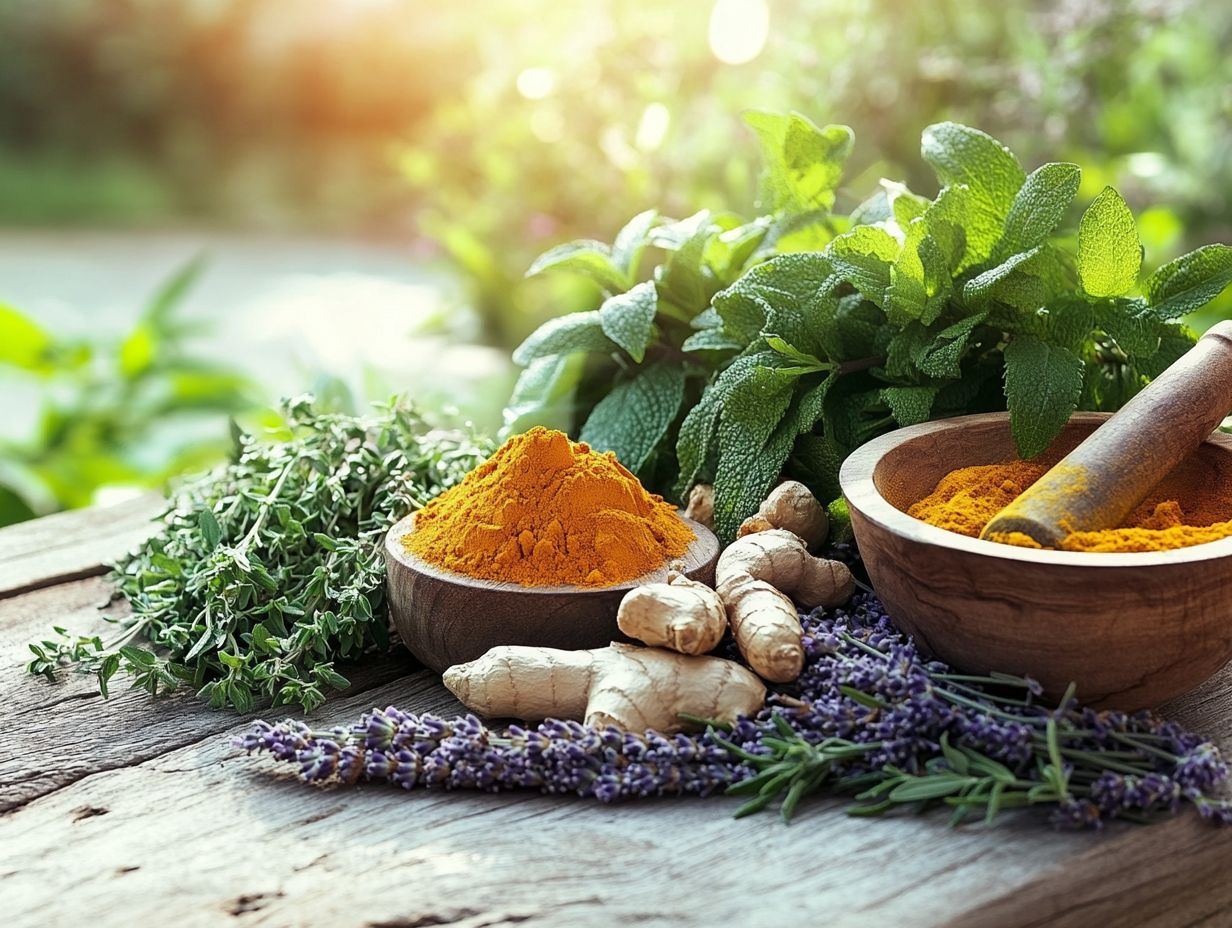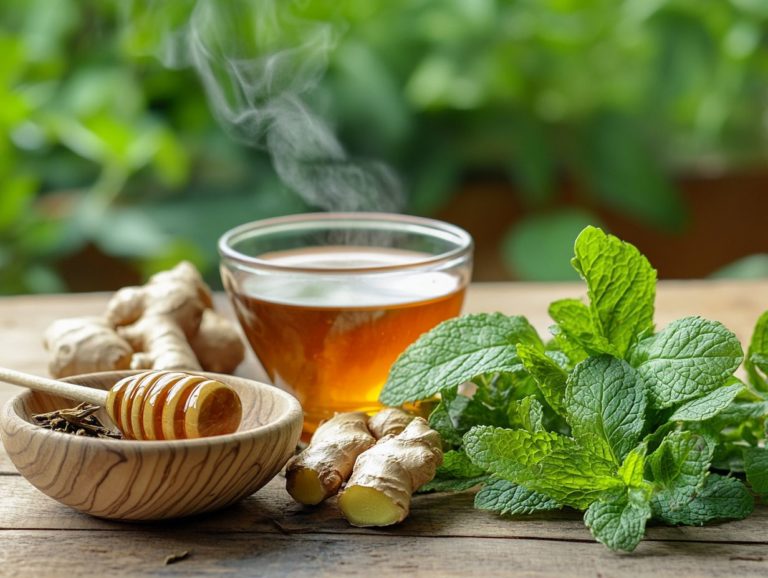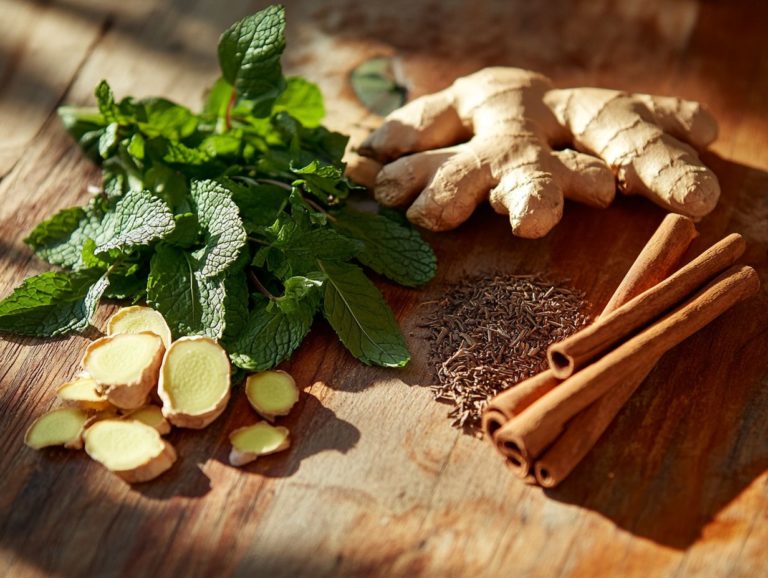Herbs for Managing Chronic Pain
Chronic pain impacts millions, weaving a complex tapestry of physical and emotional challenges that many face daily. Understanding its definition and underlying causes is essential for effective management.
Let s explore traditional pain management methods, including medications and therapies, and discover the exciting potential of herbal remedies! You ll learn how to safely incorporate herbs into your regimen, the associated risks, and why it s crucial to blend these natural approaches with conventional treatments.
Lifestyle changes can be pivotal in alleviating pain. Join us now to explore these vital aspects of managing chronic pain and empower yourself today!
Contents
- Key Takeaways:
- Understanding Chronic Pain
- Traditional Pain Management Methods
- Herbs for Chronic Pain
- Potential Risks and Side Effects
- Integrating Herbs with Conventional Treatment
- Lifestyle Changes for Managing Chronic Pain
- Frequently Asked Questions
- What are some common herbs used for managing chronic pain?
- How do herbs help in managing chronic pain?
- Are there any potential side effects of using herbs for managing chronic pain?
- Can herbs be used as a standalone treatment for chronic pain?
- What precautions should I take when using herbs for pain?
- What are some techniques for using herbs for managing chronic pain?
Key Takeaways:

- Herbs can be a game-changer for managing chronic pain!
- When using herbs for pain relief, carefully research and understand their potential risks and side effects.
- Integrating herbs with traditional pain management methods and making lifestyle changes can lead to more comprehensive and effective management of chronic pain.
Understanding Chronic Pain
Chronic pain is a multifaceted and often debilitating condition that lingers over time, impacting millions around the world. It typically arises from various underlying causes, including injuries, inflammation, or chronic diseases like arthritis. For you, this can pose significant challenges, affecting both your quality of life and daily activities.
To truly grasp the nature of chronic pain, it’s essential to appreciate the critical role that inflammation plays within the body’s pain signaling system. Understanding the various factors that contribute to chronic pain’s persistence empowers you to manage this complex condition. Exploring herbal solutions for nerve pain relief may also provide additional support in your journey toward wellness.
Definition and Causes
Chronic pain is characterized as persistent pain that lingers beyond the typical healing period, often associated with underlying conditions such as arthritis and inflammatory diseases.
In contrast to acute pain, which appears suddenly as a warning signal for injury or illness, chronic pain continues long after recovery would normally be expected and can arise without an identifiable cause. This discomfort may originate from a variety of sources, including nerve damage or alterations within the central nervous system. Your immune system plays a pivotal role in chronic pain; conditions like rheumatoid arthritis can lead to prolonged inflammation, intensifying pain sensations. To alleviate some of this discomfort, consider exploring herbs for treating digestive discomfort.
Additionally, factors such as degenerative disorders, fibromyalgia, and psychological influences can intertwine to contribute to this intricate syndrome, illustrating the multifaceted nature of persistent discomfort.
Traditional Pain Management Methods
Traditional pain management methods typically involve a thoughtful blend of medications and therapeutic approaches designed to alleviate symptoms. This is especially relevant when tackling conditions such as arthritis pain, which can profoundly impact both mobility and quality of life.
Medications and Therapies
Medications like non-steroidal anti-inflammatory drugs (NSAIDs) are often at the forefront of traditional pain management therapies, expertly designed to reduce inflammation and alleviate chronic pain symptoms.
These medications operate by blocking the enzymes responsible for pain and swelling, allowing you to experience greater comfort in your daily life. For those facing more severe pain, opioids may be prescribed, though their use is approached with caution due to the potential for dependence.
In addition to NSAIDs and opioids, incorporating additional medications such as specific antidepressants and anticonvulsants can significantly enhance your pain management outcomes. By integrating therapeutic approaches like physical therapy and acupuncture, you’re not just addressing pain; you’re also improving overall functional mobility. For those interested in natural relief, exploring popular herbs for pain relief can be beneficial.
You may find that adopting a multi-faceted strategy leads to more effective relief than relying on any single treatment alone.
Herbs for Chronic Pain

Herbs have long been celebrated as natural pain relief options, providing effective alternatives and valuable complements to traditional pain management methods. By harnessing their powerful anti-inflammatory properties, they can help alleviate chronic pain symptoms remarkably well!
Effective Herbal Remedies
Some well-known herbal remedies for chronic pain include:
- White willow bark: Contains salicin, a compound similar to aspirin.
- Boswellia: Inhibits enzymes responsible for inflammation.
- Devil’s claw: Promising for easing arthritis symptoms.
- Turmeric: Rich in curcumin, known for its antioxidant properties.
- Ginger: Contains gingerol, effective for muscle soreness and joint pain.
These natural alternatives have garnered attention for their ability to alleviate discomfort and elevate overall well-being! Observational reports underscore their effectiveness, supported by both historical traditions and modern research.
How to Use Herbs for Pain Relief
You can approach using herbs for pain relief in various ways, including herbal extracts, teas, and dietary supplements. This flexibility allows you to customize your strategy to meet your specific chronic pain needs!
Herbal teas can be an excellent choice. Simply steep them for several minutes to draw out their beneficial compounds. If you prefer convenience, capsules filled with ground herbs are a straightforward method to ensure precise dosages. Additionally, using herbs to manage diabetes symptoms through tinctures, concentrated liquid extracts, provide rapid absorption and can be easily mixed into your favorite beverages.
It’s crucial to stick to recommended dosages, as some herbs might interact with medications. Consulting a healthcare provider before starting any new herbal regimen is essential, especially for managing chronic pain. For those dealing with gastrointestinal issues, exploring herbal solutions for IBS management can also be beneficial!
Potential Risks and Side Effects
It’s crucial to understand the risks and side effects of herbal treatments before using them. This knowledge empowers you to make informed decisions about integrating these remedies into your pain management routine.
Precautions and Warnings
Precautions are essential when considering herbal treatments for managing chronic pain. It’s vital to consult healthcare professionals before starting any herbal regimen. Some remedies may provoke allergic reactions in sensitive individuals or lead to serious interactions with prescription drugs. For instance, St. John’s Wort can affect the metabolism of various pharmaceuticals, including antidepressants and anticoagulants, which may reduce their effectiveness or amplify adverse effects.
To minimize risks, disclose all medications to your healthcare provider and consider starting with lower doses. Always check for known allergens and consult credible sources to ensure a safe and beneficial experience.
Integrating Herbs with Conventional Treatment

Integrating herbs with conventional treatment allows you to embrace a holistic approach to managing chronic pain. This strategy not only enhances the overall efficacy of your treatment but also leads to greater satisfaction in your healing journey!
Combining Traditional and Herbal Pain Management
Combining traditional pain management methods with herbal solutions can elevate your approach to pain relief, tackling both the symptoms and the underlying causes of chronic discomfort.
This integrative strategy equips you with a broader array of tools. It allows you to balance conventional medications with the natural healing properties of herbs like turmeric and ginger, which are renowned for their anti-inflammatory benefits. For those seeking relief from headaches, exploring herbs for reducing headaches and migraines can also be beneficial.
Numerous case studies have demonstrated that individuals often experience remarkable improvements in their overall well-being when adopting this dual methodology. One testimonial detailed the journey of a chronic back pain sufferer who reported enhanced mobility and a reduced dependence on pharmaceuticals after incorporating herbal teas into their daily routine, along with herbal approaches to relieve back pain.
These inspiring stories reveal the amazing potential for tailored pain management strategies. They offer more holistic relief while minimizing the side effects often associated with conventional treatments. Exploring herbal solutions for managing hypertension can also provide additional benefits for overall health.
Lifestyle Changes for Managing Chronic Pain
Lifestyle changes are essential in managing chronic pain. By incorporating additional practices, you can significantly enhance your overall well-being and bolster the effectiveness of both traditional and herbal pain management strategies.
Complementary Practices for Pain Relief
Practices for pain relief, such as yoga, meditation, and acupuncture, can significantly enhance your journey toward alleviation and overall well-being, especially if you’re dealing with chronic conditions.
These holistic approaches work in harmony with herbal remedies and traditional treatments, crafting a comprehensive strategy for managing discomfort. Incorporating herbs for relieving stress-induced tension can enhance this effect. Yoga boosts flexibility and strength while encouraging relaxation, helping to relieve the tension that often worsens pain.
Meditation provides mental clarity and reduces stress, both vital components in effective pain management. Meanwhile, acupuncture stimulates specific points in the body, releasing endorphins that can further diminish pain sensations.
When you blend these practices with herbal treatments like turmeric or peppermint, you unlock a synergistic effect that maximizes relief and nurtures a more balanced state of health.
Frequently Asked Questions
What are some common herbs used for managing chronic pain?

Some common herbs used for managing chronic pain include turmeric, ginger, cannabis, willow bark, and valerian root.
How do herbs help in managing chronic pain?
Herbs contain natural anti-inflammatory and pain-relieving properties that can help reduce pain and inflammation in the body, providing relief to those with chronic pain.
Are there any potential side effects of using herbs for managing chronic pain?
While herbs are generally safe, they can still have side effects and interact with certain medications. It is important to consult with a healthcare professional before using herbs for managing chronic pain.
Can herbs be used as a standalone treatment for chronic pain?
No, herbs should not be used as a standalone treatment for chronic pain. They can be used as a complementary therapy alongside other treatments recommended by a healthcare professional.
What precautions should I take when using herbs for pain?
It is important to research and purchase high-quality herbs from reputable sources. Follow dosage instructions and monitor for any potential interactions with medications.
What are some techniques for using herbs for managing chronic pain?
Herbs can be used in various forms such as teas, tinctures, essential oils, and capsules. Some people may find relief by incorporating herbs into their diet or using them topically as a salve or poultice.
Consult with a healthcare provider to explore which herbal options might suit your needs best.






